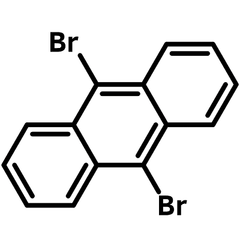9,10-Dibromoanthracene
CAS Number 523-27-3
Chemistry Building Blocks, Dibromo Monomers, Materials, Monomers, Non-Heterocyclic Building BlocksOne of anthracene derivatives that is brominated at 9,10-postions
A useful building block to construct semiconducting molecules and polymers in application of OFETs, OLEDs and organic polymer solar cells.
Specifications | MSDS | Literature and Reviews
9,10-Dibromoanthracene (CAS number 523-27-3) is a symmetrically brominated anthracene derivative that is bearing functional groups to extend its conjugation further mainly via C-C bond forming i.e. Stille and Suzuki coupling reactions. Anisotropic Poisson effect is observed in elastic 9,10-dibromoanthracene single crystals. Its bending and stretching deformation-induced fluorescence changes are observed in the solid state.
High photoluminescence quantum yields (PLQYs) of 89.5% was observed in trans-9,10-bis(2-butoxyphenyl)anthracene (BBPA). Device efficiency of a high external quantum efficiency of 10.27% for deep-blue emission with the Commission International de L'Eclairage CIE coordinates of (0.15, 0.05) was acheieved with BBPA doped 10,10′-bis-(4-fluorophenyl)-3,3′-dimethyl-9,9′-bianthracene (MBAn-(4)-F) as the emmision layer [1].
General Information
| CAS Number | 523-27-3 |
| Chemical Formula | C14H8Br2 |
| Full Name | 9,10-Dibromoanthracene |
| Molecular Weight | 336.03 g/mol |
| Synonyms | Anthracene, 9,10-dibromo- |
| Classification / Family | Anthracenes, Semiconductor synthesis intermediates, Low band gap polymers, OLED, OFETs, organic photovoltaics |
Chemical Structure

Product Details
| Purity | >98% (1H NMR) |
| Melting Point | Tm = 227 °C |
| Appearance | Yellow to orange powder/crystals |
MSDS Documentation
9,10-Dibromoanthracene MSDS Sheet
Literature and Reviews
- Efficient Deep-Blue Electrofluorescence with an External Quantum Efficiency Beyond 10%, S. Wang et al., IScience, 9, 532-541 (2018); DOI: 10.1016/j.isci.2018.10.026.
- Highly efficient non-doped blue fluorescent OLEDs with low efficiency roll-off based on hybridized local and charge transfer excited state emitters, X. Lv et al., Chem. Sci., 11, 5058-5065 (2020); DOI: 10.1039/D0SC01341B.
- Silicon-Cored Anthracene Derivatives as Host Materials for Highly Efficient Blue Organic Light-Emitting Devices, Y.-Y. Lyu et al., Adv. Mater., 20, 2720–2729 (2008); DOI: 10.1002/adma.200602885.
